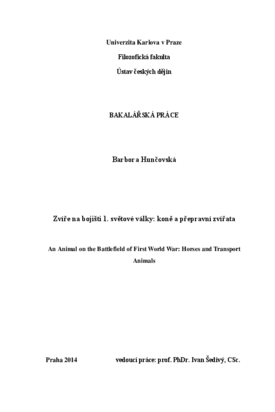Zvíře na bojišti 1. světové války: koně a přepravní zvířata
An Animal on the Battlefield of First World War: Horses and Transport Animals
bakalářská práce (OBHÁJENO)

Zobrazit/
Trvalý odkaz
http://hdl.handle.net/20.500.11956/67167Identifikátory
SIS: 127518
Kolekce
- Kvalifikační práce [22841]
Autor
Vedoucí práce
Oponent práce
Kopeček, Michal
Fakulta / součást
Filozofická fakulta
Obor
Historie
Katedra / ústav / klinika
Ústav českých dějin
Datum obhajoby
16. 6. 2014
Nakladatel
Univerzita Karlova, Filozofická fakultaJazyk
Čeština
Známka
Výborně
Klíčová slova (česky)
první světová válka, kůň, zvíře, tažné zvíře, kavalerie, válečný prožitekKlíčová slova (anglicky)
First World War, horse, animal, working animal, draught animal, cavalry, war experienceTématu používání přepravních zvířat v první světové válce nebylo dosud v českém prostředí věnováno takřka žádné pozornosti historiků. Předkládaná bakalářská práce se snaží tuto mezeru alespoň z části zaplnit. Postihuje cestu koní a dalších tažných, nákladních a jezdeckých zvířat celou válkou na všech jejích frontách a odpovídá na otázky, jakým způsobem byla tato zvířata ve válce využívána, s čím se na bojišti potýkala a jaké se jim dostávalo péče. Studium historických pramenů administrativní i osobní povahy domácí i zahraniční provenience kombinuje s poznatky etologie koní a jim příbuzných zvířat. Práce se dále podrobně věnuje i vztahu vojáků první světové války ke koním sloužícím v armádě a pokouší se určit místo válečných koní v obrazu a paměti první světové války.
The aim of this thesis is in part to fill the gap that exists in the Czech historiography regarding the use of horses and other transport animals in the First World War. It follows the experience of draught, pack and mounted animals in this war, from its very beginnings to the end, and tries to answer these questions: how were these animals used, what did they have to go through and encounter on the battlefield and what care they were provided. This thesis combines the use of historical sources of both administrative and personal nature with the knowledge and observations gained from the field of horse ethology. It also addresses in detail the relationship between fighting men and their horses and tries to paint the picture of the role of war horses in the representation and memory of the First World War.
